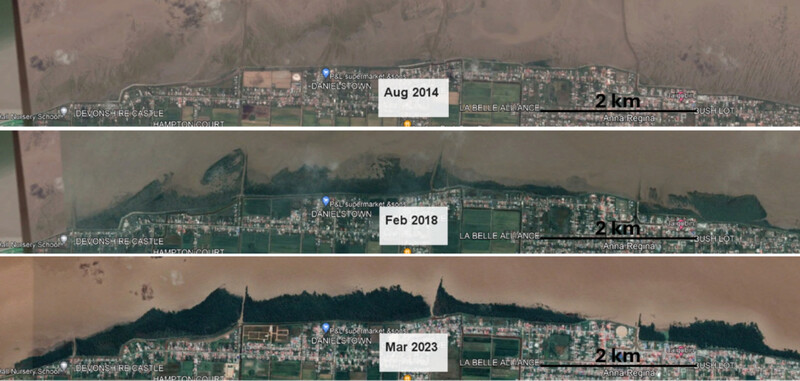B.P. Smits1* & J.C. Winterwerp2,3
1 Deltares, the Netherlands; 2 Delft University of Technology, Fac Civil Eng and GeoSc, Dept Hydraulic Engineering, the Netherlands; 3 Wetlands International, the Netherlands
* Corresponding author: bob.smits@deltares.nl
Introduction
This abstract presents four examples of Nature-based Solutions (NbS) to restore degraded mangroves and mangrove-mud coasts. These examples are from Guyana and Suriname, and are meant to provide inspiration for the restoration of other such coasts.
This work was published as part of the article 'Mangrove recovery by habitat restoration using nature-based solutions' in Ecological Engineering 212: 107520 (Winterwerp et al., 2025). It can be regarded as a supplement to the Engineering with Nature Atlas issued by ERDC (2024), which focuses on temperate climate environments though.
Objective and Methods
The designs are based on a qualitative/conceptual understanding of the bio-physical system. The restoration measures utilise the natural system dynamics caused by large-scale mudbanks that migrating along the shore of the Guyana Shield (Allison and Lee, 2004; Anthony et al., 2011), and their interactions with cheniers during interbank phases (Augustinus, 1989; Anthony et al., 2014). This system understanding from literature review is supplemented by an in-depth analysis of historic satellite images and historic maps, while quantitative data are scarce, as is generally the case in these environments.
Results
Though all sites are part of the greater Guiana coastal zone and driven by the same physical processes, local conditions are so different that different NbS measures were required to catch and arrest sufficient sediments to recreate mangrove habitat. The examples in this paper show how improved drainage, coast-perpendicular groins, coast-parallel structures (breakwaters, cheniers) and (temporary) setbacks do initiate mangrove
bilitation, though have their own specific niche of deployment. When the restored mangrove forest is large enough, it may become self- maintaining. These examples are used to gain insights into why and how one solution works at one location, while elsewhere another approach was successful.

Development of green-grey coastal defence infrastructure around Anna Regina, Guyana (Google Earth satellite images). From Deltares and Conservation International (2022).
References
Allison, M.A., Lee, M.T., 2004. Sediment exchange between Amazon mudbanks and shore-fringing mangroves in French Guiana. Mar. Geol. 208 (2–4), 169–190.
Anthony, E.J., Gardel, A., Dolique, F., Marin, D., 2011. The Amazon-influenced mud- bank coast of South America: an overview of short- to long-term morphodynamics of ‘inter-bank’ areas and chenier development. J. Coast. Res. SI 64, 25–29 (ISSN 0749- 0208.).
Anthony, E.J., Gardel, A., Gratiot, N., 2014. Fluvial sediment supply, mud banks, cheniers and the morphodynamics of the coast of South America between the Amazon and Orinoco River mouths. Geol. Soc. Lond. Spec. Publ. 388 (1), 533–560.
Augustinus, P.G.E.F., 1989. Cheniers and chenier plains: a general introduction. Mar. Geol. 90, 219–229.
Deltares and Conservation International, 2022. Guyana mangrove-seawall engineering guidance. Report, 133 p. https://publications.deltares.nl/11207078.pdf.
ERDC, 2024. Engineering with Nature. https://ewn.erdc.dren.mil/.
Winterwerp, J. C., Bayney, A., Engel, S., Jack, L., Moseley, K., & Smits, B. (2025). Mangrove recovery by habitat restoration using nature-based solutions. Ecological Engineering, 212, 107520.


